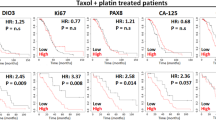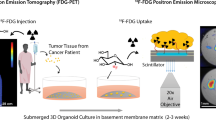Abstract
Ovarian cancer represents the fifth leading cause of cancer death among women in the United States, with >16 000 deaths expected this year. This study was carried out to investigate the potential of sodium iodide symporter (NIS)-mediated radioiodide therapy as a novel approach for ovarian cancer treatment. Radioiodide is routinely and effectively used for the treatment of benign and malignant thyroid disease as a result of native thyroidal expression of NIS, which mediates iodide uptake. In vitro gene transfer studies in ovarian cancer cells revealed a 12- and five-fold increase in iodide uptake when transduced with Ad/CMV/NIS or Ad/MUC1/NIS, respectively. Western blot/immunohistochemistry confirmed NIS protein expression. In vivo ovarian tumor xenografts were infected with the adenoviral constructs. 123I imaging revealed a clear image of the CMV/NIS-transduced tumor, with a less intense image apparent following infection with MUC1/NIS. Therapeutic doses of 131I following CMV/NIS infection caused a mean 53% reduction in tumor volume (P<0.0001). MUC1/NIS-transduced tumors did not regress, although at 8 weeks following therapy, tumor volume was significantly less that of control animals (166 versus 332%, respectively, P<0.05). This study represents a promising first step investigating the potential for NIS-mediated radioiodide imaging and therapy of ovarian tumors.
This is a preview of subscription content, access via your institution
Access options
Subscribe to this journal
Receive 12 print issues and online access
$259.00 per year
only $21.58 per issue
Buy this article
- Purchase on Springer Link
- Instant access to full article PDF
Prices may be subject to local taxes which are calculated during checkout





Similar content being viewed by others
Abbreviations
- NIS:
-
sodium iodide symporter
- CMV:
-
cytomegalovirus
- MOI:
-
multiplicity of infection.
References
Jemal A, Murray T, Ward E, Samuels A, Tiwari RC, Ghafoor A et al. Cancer Statistics, 2005. CA Cancer J Clin 2005; 55: 10–30.
Ozols RF, Bookman MA, Connolly DC, Daly MB, Goldwin AK, Schilder RJ et al. Focus on epithelial ovarian cancer. Cancer Cell 2004; 5: 19–24.
NIH Consensus Conference. Ovarian cancer. Screening, treatment, and follow-up. NIH Consensus Development Panel on Ovarian Cancer. JAMA 1995; 273: 491–497.
Ozols RF . Management of advanced ovarian cancer consensus summary. Advanced Ovarian Cancer Consensus Faculty. Semin Oncol 2000; 27: 47–49.
Kigawa J, Sato S, Shimada M, Takahashi M, Itamochi H, Kanamori Y et al. p53 gene status and chemosensitivity in ovarian cancer. Hum Cell 2001; 14: 165–171.
Gaducci A, Cosio S, Muraca S, Genazzani A . Molecular mechanisms of apoptosis and chemosensitivity to platinum and paclitaxel in ovarian cancer: biological data and clinical implications. Eur J Gynaecol Oncol 2002; 23: 390–396.
Coukos G, Rubin SC . Chemotherapy resistance in ovarian cancer: new molecular perspectives. Obstet Gynecol 1998; 91: 783–792.
Dohan O, Carrasco N . Advances in Na+/I− symporter (NIS) research in the thyroid and beyond. Mol Cell Endocrinol 2003; 213: 59–70.
Spitzweg C, Dietz AB, O'Connor MK, Bergert ER, Tindall DJ, Young CYF et al. In vivo sodium iodide symporter gene therapy of prostate cancer. Gene Therapy 2001; 8: 1524–1531.
Nakamoto Y, Saga T, Misaki T, Kobayashi H, Sato N, Ishimori T et al. Establishment and characterization of a breast cancer cell line expressing Na+/I− symporters for radioiodide concentrator gene therapy. J Nucl Med 2000; 41: 1898–1904.
Boland A, Marcel R, Opolon P, Bidart J-M, Yeh P, Filetti S et al. Adenovirus-mediated transfer of the thyroid sodium-iodide symporter gene into tumors for a targeted radiotherapy. Cancer Res 2000; 60: 3484–3492.
Dingli D, Diaz RM, Bergert ER, O'Connor MK, Morris JC, Russell SJ . Genetically targeted radiotherapy for multiple myeloma. Gene Therapy 2003; 102: 489–496.
Cho J-Y, Shen DHY, Yang W, Williams B, Buckwalter TLF, LaPerle KMD et al. In vivo imaging and radioiodine therapy following sodium iodide symporter gene transfer in animal model of intracerebral gliomas. Gene Therapy 2002; 9: 1139–1145.
Groot-Wassink T, Aboagye EO, Glaser M, Lemoine NR, Vassaux G . Adenovirus biodistribution and noninvasive imaging of gene expression in vivo by positron emission tomography using human sodium/iodide symporter as reporter gene. Hum Gene Ther 2002; 13: 1723–1735.
Carlin S, Cunningham SH, Boyd M, McCluskey AG, Mairs RG . Experimental targeted radioiodide therapy following transfection of the sodium iodide symporter gene: effect on clonogenicity in both two- and three-dimensional models. Cancer Gene Ther 2000; 7: 1–8.
Kakinuma H, Bergert ER, Spitzweg C, Cheville JC, Lieber MM, Morris JC . Probasin promoter (ARR2PB)-driven, prostate-specific expression of the human sodium iodide symporter (h-NIS) for targeted radioiodine therapy of prostate cancer. Cancer Res 2003; 15: 7840–7844.
Dwyer RM, Bergert ER, O'Connor MK, Gendler SJ, Morris JC . In vivo radioiodide imaging and treatment of breast cancer xenografts following MUC1-driven expression of the sodium iodide symporter (NIS). Clin Cancer Res 2005; 11: 1483–1489.
Ichige K, Perry L, Vogel CA, Buchegger F, Kufe D . Expression of the DF3-P epitope in human ovarian carcinomas. Clin Cancer Res 1995; 1: 565–571.
Dong Y, Walsh MD, Cummings MC, Wright RG, Khoo SK, Parsons PG et al. Expression of MUC1 and MUC2 mucins in epithelial ovarian tumors. J Pathol 1997; 183: 311–317.
Stimpfl M, Schmid BC, Schiebel I, Tong D, Leodolter S, Obermair A et al. Expression of mucins and cytokeratins in ovarian cancer cell lines. Cancer Lett 1999; 145: 133–141.
Feng H, Ghazizadeh M, Konishi H, Araki T . Expression of MUC1 and MUC2 gene products in human ovarian carcinomas. Jpn J Clin Oncol 2002; 32: 525–529.
Zeimet AG, Muller-Holzner E, Schuler A, Hartung G, Berger JT, Hermann M et al. Determination of molecules regulating gene delivery using adenoviral vectors in ovarian carcinomas. Gene Therapy 2002; 9: 1093–1100.
You Z, Fischer DC, Tong X, Hasenberg A, Aguilar-Cordova E, Kieback DG . Coxsackievirus–adenovirus receptor expression in ovarian cancer cell lines is associated with increased adenovirus transduction efficiency and transgene expression. Cancer Gene Ther 2001; 8: 168–175.
Hart IR . Tissue specific promoters in targeting systemically delivered gene therapy. Semin Oncol 1996; 23: 154–158.
MIRD dose estimate report No. 5: summary of current radiation dose estimates to humans from 123I, 124I, 126I, 130I, 131I and 132I as sodium iodide. J Nucl Med 1975; 16: 857–860.
Mazzaferri E, Kloos R . Current approaches to primary therapy for papillary and follicular thyroid cancer. J Clin Endocrinol Metab 2001; 86: 1447–1463.
Wapnir IL, Van DeRijn M, Nowels K, Amenta PS, Walton K, Montgomery K et al. Immunohistochemical profile of the human sodium/iodide symporter in thyroid, breast, and other carcinomas using high density tissue microarrays and conventional sections. J Clin Endocrinol Metab 2003; 88: 1880–1888.
Mandell RB, Mandell LZ, Link CJ . Radioisotope concentrator gene therapy using the sodium/iodide symporter gene. Cancer Res 1999; 59: 661–668.
Tai Y-T, Strobel T, Kufe D, Cannistra SA . In vivo cytotoxicity of ovarian cancer cells through tumor-selective expression of the BAX gene. Cancer Res 1999; 59: 2121–2126.
Casado E, Gomez-Navarro J, Yamamoto M, Adachi Y, Coolidge CJ, Arafat WO et al. Strategies to accomplish targeted expression of transgenes in ovarian cancer for molecular therapeutic applications. Clin Cancer Res 2001; 7: 2496–2504.
Ring C, Blouin P, Martin L-A, Hurst HC, Lemoine NR . Use of transcriptional regulatory elements of the MUC1 and ERBB2 genes to drive tumor-selective expression of a prodrug activating enzyme. Gene Therapy 1997; 4: 1045–1052.
Dmitriev I, Krasnykh V, Miller CR, Wang M, Kashentseva E, Mikheeva G et al. An adenovirus vector with genetically modified fibers demonstrates expanded tropism via utilization of a coxsackievirus and adenovirus receptor-independent cell entry mechanism. J Virol 1998; 72: 9706–9713.
Kanerva A, Bauerschmitz GJ, Yamamoto T, Lam JT, Alvarez RD, Siegal GP et al. A cyclooxygenase-2 promoter-based conditionally replicating adenovirus with enhanced infectivity for treatment of ovarian adenocarcinoma. Gene Therapy 2004; 11: 552–559.
Breidenbach M, Rein DT, Wang M, Nettelback DM, Hemminki A, Ulasov I et al. Genetic replacement of the adenovirus shaft fiber reduces liver tropism in ovarian cancer gene therapy. Hum Gene Therapy 2004; 15: 509–518.
Wu H, Han T, Lam JT, Leath CA, Dmitrev I, Kashentseva E et al. Preclinical evaluation of a class of infectivity-enhanced adenoviral vectors in ovarian cancer gene therapy. Gene Therapy 2004; 11: 874–878.
Weiss S, Philip N, Grollman E . Iodine transport in a continuous line of cultured cells from rat thyroid. Endocrinology 1984; 114: 1090–1098.
Spitzweg C, Zhang Z, Bergert ER, Castro MR, McIver B, Heufelder AE et al. Prostate-specific antigen promoter-driven androgen-inducible expression of sodium iodide symporter in prostate cancer cell lines. Cancer Res 1999; 59: 2136–2141.
Castro RM, Bergert ER, Beito TG, McIver B, Goellner JR, Morris JC . Development of monoclonal antibodies against the human sodium iodide symporter: immunohistochemical characterization of this protein in thyroid cells. J Clin Endocrinol Metab 1999; 84: 2957–2962.
Acknowledgements
The Prospect Creek Foundation provided the main source of funding for this work. Support was also received from the Mayo Foundation Breast Cancer grant, Prostate Cancer SPORE grant (CA91956) and the Mayo Breast Cancer Program.
Author information
Authors and Affiliations
Corresponding author
Rights and permissions
About this article
Cite this article
Dwyer, R., Bergert, E., O'Connor, M. et al. Sodium iodide symporter-mediated radioiodide imaging and therapy of ovarian tumor xenografts in mice. Gene Ther 13, 60–66 (2006). https://doi.org/10.1038/sj.gt.3302599
Received:
Revised:
Accepted:
Published:
Issue Date:
DOI: https://doi.org/10.1038/sj.gt.3302599
Keywords
This article is cited by
-
In Vitro Radionuclide Therapy and In Vivo Scintigraphic Imaging of Alpha-Fetoprotein-Producing Hepatocellular Carcinoma by Targeted Sodium Iodide Symporter Gene Expression
Nuclear Medicine and Molecular Imaging (2013)
-
Enhanced anti-tumor effects of combined MDR1 RNA interference and human sodium/iodide symporter (NIS) radioiodine gene therapy using an adenoviral system in a colon cancer model
Cancer Gene Therapy (2010)
-
A probasin promoter, conditionally replicating adenovirus that expresses the sodium iodide symporter (NIS) for radiovirotherapy of prostate cancer
Gene Therapy (2010)
-
Construction of an MUC-1 promoter driven, conditionally replicating adenovirus that expresses the sodium iodide symporter for gene therapy of breast cancer
Breast Cancer Research (2009)
-
Converting Tumor-specific Markers Into Reporters of Oncolytic Virus Infection
Molecular Therapy (2009)



